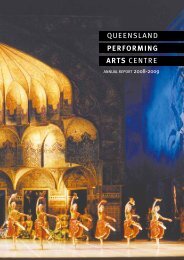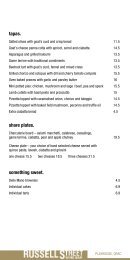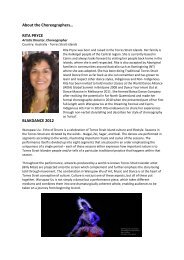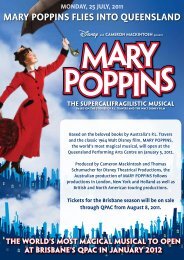Download - QPAC
Download - QPAC
Download - QPAC
Create successful ePaper yourself
Turn your PDF publications into a flip-book with our unique Google optimized e-Paper software.
An editorial in Pravda labelled it a “balletic fraud”, with its depiction of socialist peasants as “sugary paysans<br />
from a pre-revolutionary chocolate box”.<br />
As Judith Mackrell wrote in her biography of the ballerina, Lydia Lopokova, sister of Fyodor Lopokov, “the<br />
only artistic crime apparently committed [by the choreographer and librettist] was to put the ballet’s cast of<br />
farmworkers in pointe shoes, and to show them performing classical steps rather than ‘local folk dances and<br />
games’; yet as a result, the librettist, Adrian Piotrovsky was sent to the gulag (from which he never returned)”.<br />
Even before the premiere of The Limpid Stream, Shostakovich was out of favour with Stalin who hated his<br />
Lady Macbeth of Mtsensk, an opera ridiculed by the newspaper, Pravda, as a “confused stream of sound”<br />
filled with “quacks, grunts, and growls”. Just one week after this denunciation, Pravda went in for the kill,<br />
describing the score for The Limpid Stream as “music without character”. Shostakovich never wrote another<br />
ballet score.<br />
As for Lopokov, newly promoted as director of the Bolshoi Ballet, he was stripped from the role and his<br />
career almost came to an end.<br />
Many years later, Ratmansky’s rescue of Lopokov’s reputati on was an important factor in his recreation of the<br />
ballet and it’s easy to see him as a successor to Lopokov in his love of narrative, his fascination with Russian<br />
history and social life, and his love of the work of Shostakovich.<br />
Asked by The New York Times what draws him to the music of Shostakovich, Ratmansky said: “He’s very<br />
Russian. You can learn the history of the country from his music. He was very sensitive, very true, even if he<br />
had to have a mask on. Like Dostoyevsky and Tolstoy, on that level of diving deep into the soul and the time.<br />
His music answers so many questions.<br />
“He was the child of the Russian avant-garde, super brave and grotesque, almost evil. And then in the ’30s he<br />
went through such pressure, it crushed his self-importance. He expected arrest every night. His friends and<br />
relatives were arrested and killed. It changed his ideas of what the artist should be”.<br />
Although Ratmansky has been artist-in-residence at American Ballet Theatre in New York since 2008, his<br />
choreography continues to honour the legacy of his Russian predecessors, such as Leonide Massine, who<br />
danced at the Bolshoi before joining Diaghilev’s Ballets Russes where he carried on the Bolshoi traditions<br />
of character dancing, mime, and comedy in ballets such as Gaité Parisienne and Scuola di ballo (the last rechoreographed<br />
by Ratmansky for The Australian Ballet in 2009).<br />
The Bright Stream, in particular, is built around character and demi-character roles of the kind that enlivened<br />
the ballets of the English choreographers, John Cranko and Frederick Ashton.<br />
Just as Ashton’s Cinderella features men in drag as the Ugly Stepsisters, and the ladies of Portsmouth in<br />
Cranko’s Pineapple Poll disguise themselves as sailors to go searching for desirable captain of HMS Hot<br />
Cross Bun, Ratmansky’s Bright Stream features cross dressing, a tangled web of confused identities, and a<br />
semi-farcical plot as complex as The Marriage of Figaro and A Midsummer Night’s Dream.<br />
The story unfolds against Boris Messerer’s sets of harvest produce and wheat with the ballet’s colourful<br />
array of roles including an accordion player who chases a schoolgirl, Zina, the entertainment director of<br />
the collective farm, called The Bright Stream, Zina’s husband, Pyotr, an agricultural student enchanted by<br />
the visiting Ballerina, her partner, the Ballet Dancer, and an Old Dacha Dweller and his wife, titled The<br />
Anxious-to-be-younger-than-she-is-Dacha Dweller.<br />
Among all the carnival-like festivity and vaudevillian pranks, the leading dancers perform virtuoso solos and<br />
pas de deux that are all the more impressive as the Ballerina and her partner dance very convincingly as the<br />
opposite sex.<br />
Like Maurice Béjart’s Le Concours and Jerome Robbins’s The Concert, The Bright Stream makes jokes about<br />
ballet – its mannerisms and outdated concepts of fragile women, lovesick men and happy ever aftering. But<br />
the only successful jokes about ballet are made by the men and women who love the art form the most.<br />
Ratmansky is clearly among them.<br />
Not to be copied or reproduced.
















